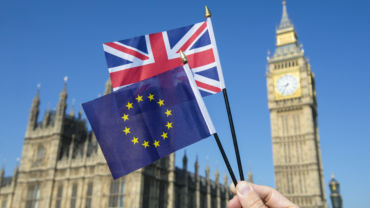After Prime Minister Theresa May secured her mandate in December 2017 to move on to the second phase of Article 50 (‘Brexit’) negotiations, the focus in 2018 will now shift to transition and the UK’s future outside of the European Union (EU). However, with challenges at home and abroad, it will not be easy.
Moving on from sufficient progress
The start of the second phase of negotiations came on 15 December 2017, after the European Council adopted guidelines formally accepting that there had been ‘sufficient progress’ in the negotiations with the UK to proceed to the next phase. The key aims of the second phase are, most immediately, to address transitional arrangements, and, from March 2018, to have ‘preliminary and preparatory discussions with the aim of identifying an overall understanding of the framework for the future relationship’.
The overall aim of Brexit talks will be to conclude a formal withdrawal agreement governing the UK’s exit from the EU in March 2019. This will incorporate all the terms agreed in December 2017, as well as addressing many other withdrawal issues that were not fully resolved in the first phase, including the future of the Irish border, issues surrounding the governance of the withdrawal agreement itself, and the UK’s role in the European Atomic Energy Community.
It is likely that the withdrawal agreement will also cover the terms of the transition and it might also be accompanied by political declaration setting out any final understanding reached in the Brexit talks on the ‘framework’ for the future UK-EU relationship; however, the full agreement (or agreements) on the future relationship is founded on a different legal basis and will be finalised and concluded after the UK has left the EU.
The EU’s Chief Brexit Negotiator Michel Barnier has said that the EU would be ready to present an initial draft of the withdrawal agreement in early 2018. Both sides intend to agree on the final draft by October 2018 (to allow time for ratification by March 2019), which means there is an incredibly tight timetable for this year’s talks.
Avoiding a cliff-edge?
With just 15 months to go until the UK leaves the EU, David Davis, the Secretary of State for Exiting the EU, has expressed a desire to get the ‘outlines’ of an implementation period agreed in the first quarter of 2018. However, the UK would need to reach a legally binding agreement to give businesses absolute certainty on an implementation period, which Davis said could be as late as the UK’s exit date in March 2019.
Under discussion is a ‘standstill’ transition, which means that the UK will continue to participate in the customs union and single market during the transitional period. The EU has emphasised that all existing EU regulatory, budgetary, supervisory, judiciary and enforcement instruments and structures will also apply to the UK during that time, including the competence of the European Court of Justice and any changes to the EU Acquis.
The narrative of the transition — particularly a standstill one — is likely to be a contentious issue as the talks go on: hard-Brexiters are unlikely to be satisfied with a status quo period and will feel a sense of betrayal, while the softer-Brexiters and Remainers will feel there was no point to Brexit if there is a status quo minus an influential say on EU rules. From a legal perspective, it would also make more sense for the UK to leave the EU after the transition period. This would give certainty during the transition over legal issues such as whether or not any particular EU law applies to the UK (as all would apply), or whether or not the UK would continue to benefit from the EU’s trade agreements with other countries during that period (as the UK would continue to benefit) as well as maintaining the UK’s influence on EU law during transition. But this would not be politically palatable as it is incompatible with the government’s stated objective of leaving the EU on 30 March 2019.
Of course, agreeing on transitional arrangements does not automatically remove the prospect of a cliff-edge Brexit. The EU has said that it wants the transition period to come to an end on 31 December 2020 (which would match its budget cycle), whereas the UK government will probably argue for a period of two years from March 2019. The UK has also repeatedly stressed that ‘nothing is agreed until everything is agreed’, meaning that the withdrawal agreement — and with it, the transition — can fall apart. According to May, the eventual withdrawal agreement is conditional on the UK getting a future relationship agreed by March 2019.
Looking to the future
While the notion of transition is generally greeted with optimism and points towards a more certain future, there’s a paradox in that the UK has not yet clearly set out its post-Brexit plans. Despite the flurry of future partnership papers in mid-2017, government debate on the Brexit end-state has barely begun — and remarkably, the cabinet only had its first formal discussion on this in December 2017. Seeking consensus on what kind of future relationship the UK is to pursue will inevitably be a protracted process, though there has been no suggestion that May will demur from the roadmap set out in her Lancaster House and Florence speeches last year. Some commentators believe that she could give another set-piece speech early in 2018 to provide further clarity on the kind of Brexit the UK seeks.
The European Council anticipates adopting new negotiating guidelines on the framework of a future relationship in March 2018. Any common understanding on the framework reached in the second phase of Brexit negotiations is only likely to result in a political declaration, given that the parties cannot reach a legally binding agreement on the future relationship until after the UK leaves the EU. The European Council has described these second phase negotiations in restrictive terms, as ‘preliminary and preparatory discussions with the aim of identifying an overall understanding of the framework for the future relationship’. Once negotiations are concluded, any agreement on the final withdrawal terms will face intense scrutiny as Parliament exercises its ‘meaningful vote’. As things stand, Parliament must approve the final terms by statute before the government can enter into a binding treaty commitment with the EU.
The UK, rather optimistically, believes that it can reach, in effect, a shadow agreement on a final future relationship covering the economic (i.e. trade) relationship and other aspects (such as security and defence) so that it is ready to be signed the moment the UK has left the EU. Given the incredibly tight timetable in which to agree the Article 50 withdrawal agreement, and the fact that trade deals with the EU can take several years to complete (the EU-Canada deal took seven years to conclude), this is highly unlikely. The future relationship agreement would need to be negotiated in parallel with the Article 50 agreement on withdrawal and transition, but could not be formally concluded until after the UK leaves the EU.
Challenges ahead
While the Brexit negotiations will provide their own tension for the government, politics at home and abroad could add further complications. May is likely to stay on as Prime Minister, despite being seen as weak since the June 2017 election. Few in the Conservative Party will want to risk another election and the possibility of a Jeremy Corbyn-led Labour victory.
Though internal European politics have not greatly affected the Brexit negotiations so far, many will still be looking to see how German Chancellor Angela Merkel fares in forming a new coalition government. The UK will be hoping that domestic turbulence for the EU’s biggest member will result in a weakened EU position on the future negotiations.
The year ahead therefore presents an opportunity to look to the future and visualise the Brexit end-state, however given the immense difficulties ahead for the UK and EU, 2018 should be taken as an opportunity to acknowledge the limits of what is possible.


